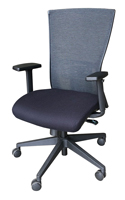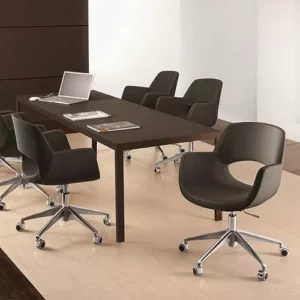For most people, working means sitting behind an office desk for hours. As such, it only makes sense to have a comfortable chair. Getting the right office chair has been attributed to improved productivity.
When most people are asked, they tend to prefer ergonomic chairs. Sadly, some do not even have an idea of what an ergonomic chair is or what it looks like. In this post, we will tell you all you need to know about such office chairs. At the end of the day, you will know what to look for in an ergonomic office chair.
What is an Ergonomic Office Chair?
An ergonomic office chair is designed to offer support to the user. The aim is to reduce strain on the body, especially on the back, neck, and shoulders. When you sit on such a chair, you will find that it contours to your body shape. As a result, it offers much-needed support.
shoulders. When you sit on such a chair, you will find that it contours to your body shape. As a result, it offers much-needed support.
Ergonomic office chairs are specially designed chairs that help to minimize stress on the body while sitting. The chair is designed to fit the contours of the body, providing support to the back, neck, and shoulders.
There are many different types of ergonomic office chairs available on the market, each with its own unique features. Here are some of the most popular types of ergonomic chairs:
- Ball Chair: A ball chair is a type of ergonomic chair that is designed to improve posture and balance. The chair is similar to a stability ball, but it has a base and legs for support.
- Kneeling Chair: A kneeling chair is a type of ergonomic chair that helps to reduce strain on the back and neck. The chair is designed so that the user kneels instead of sitting, with the knees and hips at a 90-degree angle.
- Saddle Chair: A saddle chair is a type of ergonomic chair that is designed to reduce strain on the back and neck. The chair is similar to a traditional office chair, but the seat is shaped like a saddle, with a higher back and no armrests.
Benefits of Using Ergonomic Office Chairs
There are many benefits of using ergonomic office chairs, including:
- Improved posture: Ergonomic office chairs can help to improve your posture by providing support to the back and neck.
- Reduced strain: Ergonomic office chairs can help to reduce strain on the body, especially on the back, neck, and shoulders.
- Improved productivity: Ergonomic office chairs have been linked to improved productivity. One study found that workers who used ergonomic chairs were more productive than those who didn’t.
- Reduced risk of injury: Ergonomic office chairs can help to reduce the risk of injuries, such as carpal tunnel syndrome and tendonitis.
What to Look for in an Ergonomic Office Chair
When choosing an ergonomic office chair, there are several features to look for. Here are some of the most important features to consider:
- Adjustability: One of the most important features of an ergonomic chair is adjustability. The chair should be able to adjust to fit your
 body size and shape. The seat should be adjustable up and down, and the backrest should be adjustable up and down and in and out.
body size and shape. The seat should be adjustable up and down, and the backrest should be adjustable up and down and in and out. - Armrests: Another important feature to look for in an ergonomic chair is adjustable armrests. The armrests should be able to adjust up and down, in and out, and side to side. This will allow you to find the perfect position for your arms, reducing strain on your shoulders and neck.
- Headrest: A headrest is a nice feature to have in an ergonomic chair. The headrest should be adjustable up and down and in and out. This will allow you to find the perfect position for your head, reducing strain on your neck.
- Lumbar support: Lumbar support is a must-have in an ergonomic chair. The lumbar support should be adjustable up and down and in and out. This will allow you to find the perfect position for your lower back, reducing strain on your back.
- Backrest Recline: The backrest should be able to recline. This will allow you to find the perfect position for your back, reducing strain on your back. With the ideal backrest, you will get the right support on your back and the rest of the body.
- Footrest: A footrest is a key feature to have in an ergonomic chair. The footrest should be adjustable up and down and side to side. This will allow you to find the perfect position for your feet, reducing strain on your legs and back.
- Wheels: Wheels are a necessary feature on an ergonomic chair. The wheels should be made of a soft material, such as rubber, to reduce noise and protect your floor. The wheels should also be lockable, so the chair doesn’t roll away from you.
- Swivelling: Swivelling is another important feature of an ergonomic chair. The chair should be able to swivel 360 degrees, so you can reach anything you need without straining your body.
- Material: The material of the chair is important for both comfort and durability. The seat and back should be made of a breathable mesh material, such as fabric or leather. The frame should be made of sturdy material, such as steel or aluminium.
- Maximum weight capacity: When choosing an ergonomic chair, make sure to check the maximum weight capacity. This is important to ensure that the chair will be able to support your weight.
- Warranty: Another important consideration when choosing an ergonomic chair is the warranty. Most chairs come with a one-year warranty. However, some higher-end chairs come with a longer warranty. Make sure to check the warranty before making your purchase.
Conclusion
An ergonomic office chair is a specially designed chair that helps to reduce strain on the body. When choosing an ergonomic chair, there are several features to look for, including adjustability, armrests, headrest, lumbar support, backrest recline, footrest, wheels, swivelling, material, maximum weight capacity, and warranty.
We are proud to offer a wide range of ergonomic office chairs. Talk to us and we will help you get the right pick for your office.









